For more on this fascinating story, navigate here.
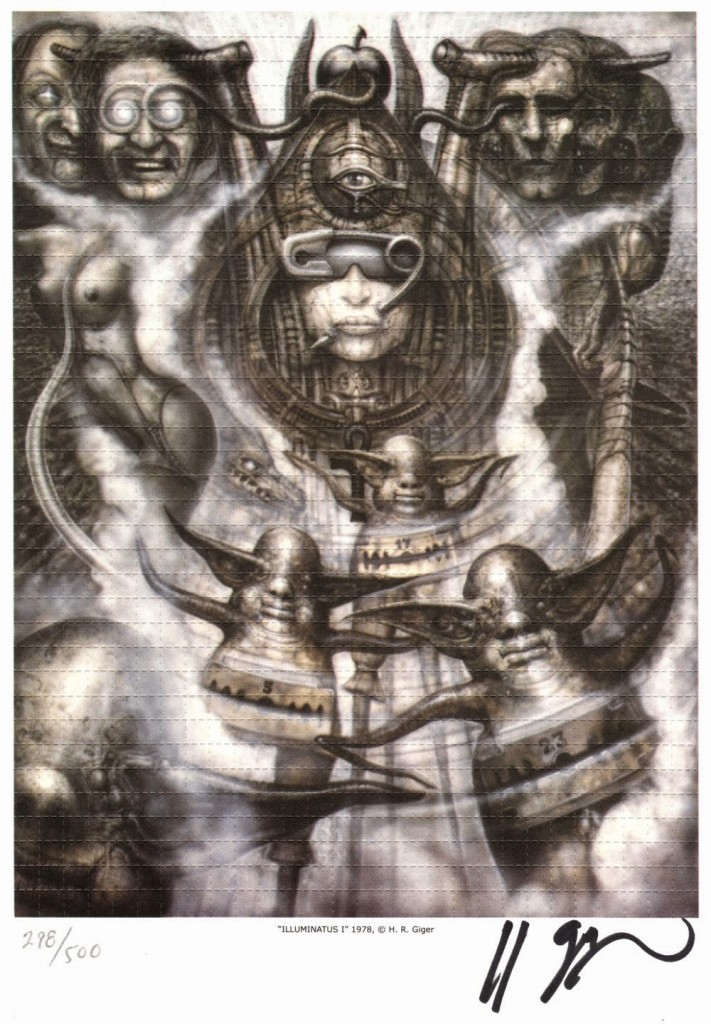
For more on this fascinating story, navigate here.

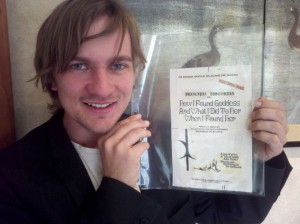
The following is another draft excerpt from my forthcoming book Chasing Eris.
The book documents my worldwide adventure to experience modern Discordian culture, meet its personalities, and discover elusive Erisian mysteries.
—Brenton Clutterbuck

Adam Gorightly gives me details for Tantra Bensko in the early part of my trip; a woman who had lived for a time with Kerry Thornley. I make contact, and we agree to meet at her house in California.
In our meeting we talk about what it was like to live with Kerry in Little Five Points, Atlanta. It seems important to mention that at the time they met, Kerry was, according to some, veering off into paranoia. I myself remain agnostic on some of his claims and skeptical of some others, especially his theory that his “real father” was a Nazi Admiral.
Tantra greets me at the entrance of her house, near a garden filled with gigantic cacti. She is smiley and excitable, and her passion for life is contagious.
She grew up in Indiana, in an area where very few people were around, few enough that one didn’t need to put clothes on to collect the mail on a hot day. She would go to Alabama, now and then, to see relatives. It was the kind of town where you couldn’t really admit to not being religious. She would attend Straight Creek Holiness Church, where people would yell and run around the congregation when the spirit seized them. When the spirit seized preachers, they would handle the snakes; a sign on the church quoted Mark 16:18, They shall take up serpents; and if they drink any deadly thing, it shall not hurt them. The spirit never seemed to seize them in her presence. When she was in Alabama, she missed the people she could engage with in California, and when she was away she missed the nature.
Tantra has a special relationship with nature. She spent years traveling the country in her van, sometimes driving out to a natural place, and finding a spot to sleep out in the open. It was during this period of travel that she began to develop her skills in Tantric yoga, healing, and her own construction of a form of effortless movement, called ‘Lucid Play.’
Tantra was in Little Five Points when she met someone who connected her with Kerry Thornley, who was to take a significant place in her life.
“I had been in Atlanta in Little Five Points and I met this guy who was the figurehead of Little Five Points. He would stand there and he would ring his bell and he would burn his sage and he would figure out who should meet whom. So he was telling me about Kerry Thornley and showing these broadsheets that he had put up and they were great political activism mixed with absurd, wild craziness. And so I wanted to meet him, and I thought, I want to come back to Atlanta to spend time with Kerry Thornley. And he was, I guess, 60 or something like that.
“And so then later I was going to Atlanta. I thought it was going to be just for a weekend but then my van broke down so I had to find a place to live. I was reading The Illuminatus! Trilogy. It was dedicated to Kerry. I stayed with that guy that I mentioned. His friend Wilson Leary, Timothy Leary’s cousin, came by, he and I started dating. So I’ve got all these things in the world of Kerry Thornley like…” she waves her arms and makes sounds to imitate the ineffable presence of Thornleyness that was entering her sphere.
“So I was trying to figure out where I was going to live and this guy just came up to me in Little Five Points and said, ‘If you’re looking for a place to live, you can live with me, I’ve got a porch.’ I checked out this house and they’ve got a big porch and so I moved in. It was a really wild artistic kind of place. I found out that Kerry Thornley lived there in this little mother-in-law right out the back. So I went there looking for Kerry Thornley, and moved in next to him without even knowing it.”
“Do you remember the first time you actually met him?” I ask.
“Uh-huh. Coming out of my room it was like, ‘There’s Kerry Thornley!’ Or, Omar Khyaam Ravenhurst.”
“What did you two talk about the first time you met?”

“Oh, I probably was just kind of squealing and telling him how glad I was, and him just doing this great laugh. I love his laugh. It was unlike anyone else’s. I wouldn’t even try to imitate it. He had thirteen cats or something like that, some huge number of cats so you’d always hear him calling them. He was just this really sweet little cat man, and son of a Nazi, such an odd combination, he claimed. In my life I always run into these MK-ULTRA kind of people, which was a little scary sometimes, that that happens, and that’s what he was, he said.

“I was also was a little bit uneasy about how much, living with him, was that going to involve me? How much was I being watched because of it? So it became like The Illuminatus! Trilogy. Black helicopters were going over all the time, and just becoming more and more like those books.”
Kerry said there were flying helicopters over his house,” I say. I was thinking of what a friend of Kerry, Louise Lacey, had told me of Kerry’s time in Florida when I said this, though I’d forgotten the details of what I’d heard. She had told me that Jim Garrison had sent helicopters over his house.
“They were, they were,” Bensko says. “They were doing it a lot. They would even follow me around. He seemed to know what he’s talking about. People always think that he was making up these stories in his head about the mind controllers and stuff, but I don’t know. He might have been.”
It was once while they lived in this close proximity that Tantra decided to perform a Discordian ritual, after a comment Kerry made.
“He said that the beauty of Discordianism was that he didn’t have to see any other Discordian-ists. And so there were no rituals. So to fly in the face of that then and give it a little chaotic shuffle, I told him, ‘we’ve got to do a ritual then.’ He thought that was a great idea.
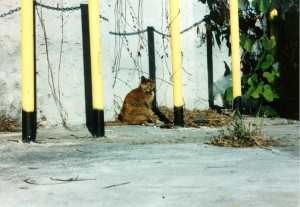
“So I got a stick of butter and I molded it into the shape of Eris the Goddess and I put it on the floor. We said something over it you know, and his thirteen cats came and positioned themselves around the butter so there was no space in between them. They were all just jammed into where their tongues were right in there in the butter and they all started spinning around in a circle all at the same time, so you had this circling cat-thing around Eris, licking it until it was gone while Kerry and I were just laughing.”

“So that was the core moment that I remember about that ritual. His cats after that walked off but kind of continuing to circle and just ‘woah hey’ and wobble off to the edges.”
“Did you spend much time with Kerry after that?” I ask.
“Oh yeah, I spent a lot of time with him when I lived in Atlanta because I was there a couple of years, and so we were really good friends. I think I spent as much time with him over those years as everyone else did altogether. He didn’t really have a lot of people come by. And the other people in the house didn’t go to see him that much. But we were buddies. We hung out. I just deeply love Kerry.
“I don’t agree with some of his politics like, ‘Kill Kennedy.’ But yeah, I really liked Kerry a lot. I felt like his writing with Eris might have had something to do with his feeling like he did inadvertently kill Kennedy by suggesting someone like Oswald could be a patsy. But who knows; it’s one layer after another it’s so complex at the time.”
When I first talked to Bensko over the Internet she pointed out that she wasn’t a Discordian and wasn’t any kind of expert, but when I spoke to her in person, she said she was identifying sometimes with the title. I asked her to tell me what about the ideology meant to her.
“It’s postmodernist,” she says. “There’s many angles, and none of them are true.” She likes that Discordia is essentially difficult to take too seriously, and finds the attitude of believing without believing useful to her work. “There’s lots of Gods in Tantra Yoga too, and I see them as physics principles,” she tells me.

We chat for a long time; Tantra is someone who it is immensely easy to be around. She carries an effortless friendliness that invites you in and asks you to engage, without needing to say the words. She talks about many things, including her time in Little Five Points, her Yoga experience and her book, Collapsible Horizon.
I walk home. The air is warm and still. I arrive back to the marijuana-scented hostel doors, and make my way up the winding stairs to my room.
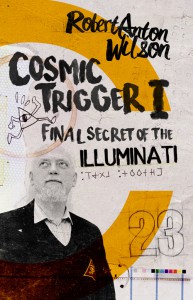
We pick up with The horrors begin (page 150 of the Hilaritas edition) through to Ishtar’s Walk: a guided tour of Hell, a section that covers RAW’s lean years after he quit his cushy Playboy job and tossed caution in the wind to devote himself to full time freelancing. This was a difficult period when he went on public assistance (the dreaded “W” word: “Welfare”) to keep his family fed and a roof over their heads in a rundown Berkeley apartment complex with neighbors on either side who appeared to be going off their heads—like so many others who emerged from the madness that’d gripped the country at the end of the 60s—from the highs of the Woodstock Nation to the lows of Altamont, Kent State and the riots of Chicago, which RAW witnessed first-hand. RAW was smack dab in the middle of the cultural sea change taking place—that all of the sudden seemed to have lost traction, like Hunter Thompson’s wave that “finally broke and rolled back.”
Before we knew it, the 70s were upon us and something had changed. So many of the heroes of the movement had either burned out or sold out or spun out. By 1973, the sixties looked a thousand light years away in the rear view mirror as the lost idealism of that decade bled over into the early seventies. A hung-over generation awoke one morning to discover President Nixon’s “War on Drugs” in full swing, its crosshairs trained on the country’s youth, poor and minorities; draconian drug laws designed, it seemed, to create a prison state of mind, with RAW’s good friend Tim Leary—who Nixon proclaimed “the most dangerous man in America”—serving as the poster boy for all things immoral and indecent.

Against this backdrop, occasional self doubt crept into RAW’s reality tunnel. Since the whole world seemed to be going mad, maybe he was, as well… filled with doubts that he’d made the worst decision of his life quitting Playboy all the while the prospect hanging over his head that he’d never become a successful writer, let alone afford to pay his bills. Also the uncertainty of Illuminatus! was still dangling in the wind, yet unpublished.
In the midst of unsure times, RAW continued his path of self discovery, practicing Sufi heart-chakra exercises to free his mind of troubles and open himself up to the wonders of the universe—which all sounds pretty new agey in retrospect, but it was a sign of the times. It was the Aquarian New Age and RAW was at the forefront, not only diving headfirst into those trendy currents, but also examining them with a critical eye. Much the same way Aleister Crowley had done decades before, by examining consciousness (magick) using the scientific method, and at the same time approaching these practices in an unbiased/unconditioned manner, the ultimate goal to metaprogram one’s self and open higher circuits.
“We place no reliance on virgin or pidgeon.
Our method is science, our aim is religion.”
It was a transition period when the counterculture crossed its own abyss—from the social activism, sexual liberation and drug induced revelations of the 60s—into a state of creeping dread brought on by Watergate, Cointelpro and the War on Drugs. Out of this madness emerged the New Age Movement, which many of the old guard radical left considered a cop out, people staring at their navels when they should be overthrowing The Man.
This period witnessed a renewed interest in the JFK assassination, as well as the other political assassinations of the late 60s, as conspiracy buffs began noticing a pattern from one assassination to another, this coupled with a deepening mistrust of government, and a growing Police State, all contributed to The Paranoid Period.
Then Kerry Thornley, high priest of Eris, re-entered my life, dragging the Kennedy Assassination horrors with him. (p.151)
At this point in the narrative, RAW brings up Thornley’s feud with Jim Garrison, which I’d be remiss if I didn’t attempt to explain. But don’t tell me I didn’t tell you it gets way convoluted.
Thornley—as weird history instructs—served with Oswald in the Marines for a short period and due to this association went on to author a couple books about his Marine Corps chum titled Oswald and Idle Warriors. Garrison conjectured that these books were written as a means to portray Oswald as a commie influenced lone nutter with an itchy trigger finger in order to set him up as a patsy in the assassination… all part of a convoluted conspiracy caper that Thornley (maybe) was party to. But I’m getting ahead of myself…
As to the nature of Garrison and Thornley’s beef, this date backs to Kerry’s association with JFK researcher David Lifton, author of the classic Kennedy assassination tome, Best Evidence.
In his initial discussions with Lifton in 1965, Thornley mentioned how Oswald spoke Russian in the ranks at El Toro with a Marine whose name he thought might have been John Renee Heindel. This revelation (that Oswald conversed in the Russian tongue with Heindel) came as a surprise to Lifton, because he was quite familiar with Thornley’s Warren Commission testimony and the fact that Kerry hadn’t actually identified Heindel as the Russian speaking Marine in question. In fact, Thornley’s only mention in the Warren Report concerning this topic is a passage where he’s trying to recollect the name of the Russian speaking Marine, and he can’t. In later conversations, Kerry admitted that he’d only recalled Heindel’s name (after delivering his testimony) when he and Warren Commission attorney, Albert Jenner, were having lunch together and Jenner provided Thornley with the name “Heindel.” How Jenner came to this conclusion (that Heindel was the guy who spoke Russian) is unclear, but it stuck in Thornley’s mind only later to be repeated to Lifton. And I haven’t even started getting convoluted yet! Hang on…

In mid 1967, Lifton discovered that our man Heindel was then living in New Orleans, which just happened to be the base of operations for Jim Garrison’s investigation and, in mid September, Lifton contacted Garrison to pass along this info about Heindel.
Not long after, Garrison called Heindel in for questioning, who denied the whole bit about speaking to Oswald in Russian. This led Garrison to somehow arrive at the conclusion that Heindel was lying. In addition, Garrison and his crew uncovered “evidence” that Heindel was seen with Oswald at several New Orleans bars during the summer of 1963. (Whether this “evidence” against Heindel was of any substance is another matter entirely.)
Long story short, Garrison wanted Thornley to travel to New Orleans to “confront” and “identify” Heindel as, you guessed it, the guy who spoke to Oswald in Russian. In the interim, Garrison requested (through Lifton) that Thornley write up a statement summarizing his memories of Oswald and Heindel. To this end, Lifton got together with Thornley (they were both living in Los Angeles at the time) and Lifton prepared an affidavit that Thornley signed and then Lifton afterwards mailed to Garrison in September 1967. Mainly, it was Lifton who behind all of this, and it’s doubtful that Thornley would have pursued the matter had not Lifton insisted.
Garrison’s ultimate plan was to call Heindel before a grand jury, and ask him if he’d ever heard Oswald speak Russian. Previously, Heindel had gone on record stating that he had not, thus it was Garrison’s assumption that Heindel would once again testify to the same tune. Then—following Heindel’s testimony—Thornley would be called into testify that he, in fact, had heard Oswald and Heindel speaking Russian—or at least that’s the convoluted scenario Garrison envisioned. As a result—according to Garrison’s madcap plan—Heindel would then be indicted for perjury. Ultimately, Garrison envisioned a far grander scenario than simply implicating Heindel as a low level player in JFK’s assassination: his eventual goal was to persuade Heindel to provide detrimental testimony against some of the other suspects in the case, like Clay Shaw.
Lifton’s willingness to cooperate with Garrison on the matter soon soured after he examined the charges against Heindel and came to the conclusion that it was a whole bunch of nothing. When Lifton informed Thornley of these developments, Kerry attempted to distance himself from Garrison’s investigation by sending this letter to the New Orleans District Attorney’s office dated October 24, 1967:
Dear Mr. Garrison,
As a personal favor to Mr. Lifton I spent a whole day with him preparing that damned affidavit. It says everything I know about the subject. I regret that I bothered.
When I said I would speak to you ON MY TERMS, as you had apparently offered to do through Mr. Lifton, I meant it. And since you chose, when I called you the first time, not to deal on those terms, to hell with it.
I have no interest to speak of in this matter and from now on intend to keep out of it, as actions on my part can only in my view stimulate the state to violate the rights of others who for all I know may be innocent. “It is far better to reward the guilty than to punish the innocent,” said Robert Ingersoll, and every time you subpoena an innocent individual you punish him to the extent that you have violated his precious and unalienable right to liberty.
But what you do is your business, sir, and you are welcome to it.
Sincerely,
Kerry Thornley

In late November 1967, Lifton met Garrison in Los Angeles, and at this time, “[Garrison] now had a brand new hypothesis. Kerry had been rapidly shifted from star-witness-to-be-list, to that of CIA agent/bad guy, who had met with and presumably conspired with Lee Oswald in the fall of 1963. The ostensive vehicle for this shift of position from star witness to culpable defendant was nothing more than a theory of the assassination postulating Kerry’s involvement invented and promulgated by Warren Report critic Harold Weisberg, and some testimony from a local New Orleans character named Barbara Reid…” —Excerpt from May 1968 letter from David Lifton to Mark Lane chronicling the Thornley/Heindel/Garrison matter. Courtesy the Discordian Archives. Read the PDF here.
Over the next three years, Thornley was repeatedly hassled by Garrison and drug through the mud. Due to all this, “[He] had begun to enter a different belief-system. He was puzzled over many aspects of the case Garrison had tried to manufacture against him, and kept brooding over the details. Basically, the case rested upon what ordinary people call coincidences. Jungians and parapsychologists call them synchronicities. Garrison called them ‘propinquities’ and said they proved the existence of “a conspiracy so vast as to stagger the imagination!” (p.151)
Garrison believed (or theorized or concocted) that Kerry Thornley was part of a JFK assassination cabal based out New Orleans, a notion that Thornley initially dismissed, but later—starting around 1973 or so—he began to suspect that Garrison might have been on the right track, at least in terms of an assassination cabal that both Oswald and Thornley were somehow associated with, or more correctly, manipulated by, and used as unwitting dupes—all of these machinations dating back to their time together in the Marines.
Thornley—as RAW notes—became obsessed with this whole notion that he’d been manipulated and perhaps even mind controlled and his paranoia grew to the extent where he began suspect that even his friends may have been in on the conspiracy, including those involved in the Discordian Society, like RAW and Bob Shea.
This scenario, among many other crazy things, are discussed in greater depth in my books The Prankster and the Conspiracy and Caught in the Crossfire, so check those out if you want to get increasingly convoluted.
Then, early in 1975, Thornley remembered an odd conversation in 1963 with a New Orleans man whom we will call Mr. M. The subject was — are you ready? — how to assassinate a President and get away with it. (p. 152).
RAW’s reference to a “Mr. M” is somewhat puzzling, as in most of Thornley’s writings he refers to the mystery man in question (who conversed with him about assassinating a President) as a pro-Nazi spook named Gary Kirstein (aka Brother-in-Law) who Kerry—at one time or another—suspected was actually Watergate burglar and CIA big-shot E. Howard Hunt (in disguise.) However—for a short period of time—Kerry suspected that Kirstein/Hunt may have actually been someone named Tom Miethe, another supposed neo-Nazi intelligence community type, so maybe that’s how RAW latched on to “Mr. M.” Or perhaps RAW wanted to avoid libel charges, so just used “Mr. M” instead of Kirstein to play it safe.
Then Thornley read about the case of Robert Byron Watson. (p. 153)
In mid 1975, Thornley came across a series of articles in Atlanta newspapers concerning the case of Robert Byron Watson, a young man who claimed he’d been framed on drug charges due to information he had regarding the MLK assassination—details of which sounded strikingly similar to Kerry’s own experience with certain shadowy characters (Gary Kirstein and Slim Brooks) in New Orleans in the early-60s. Kerry contacted Watson’s lawyers and sent them this memo outlining his knowledge of The Conspiracy:

I must point out that two weeks after Thornley first made his charges against Mr. M. (to the Atlanta police) he was robbed, pistol-whipped and had his I.D. taken. (p. 154).
As a sidebar, I recently discovered that The Discordian Archives (which were passed on to yours truly in 2009) were in RAW’s safekeeping during the period Greg Hill moved to New York City in 1974. Evidently Hill couldn’t afford or didn’t want the hassle of transporting them to New York and decided to leave them with RAW (then living in Berkeley) who became the Discordian Archives curator, so to speak. So the chain of chaotic custody over the years has been this: Greg Hill > RAW > Greg Hill > Bob Newport > Me.
RAW evidently made good use of the archives, utilizing it as source material (it would appear) for portions of Cosmic Trigger. For instance, the inclusion of the thumbprint letter.
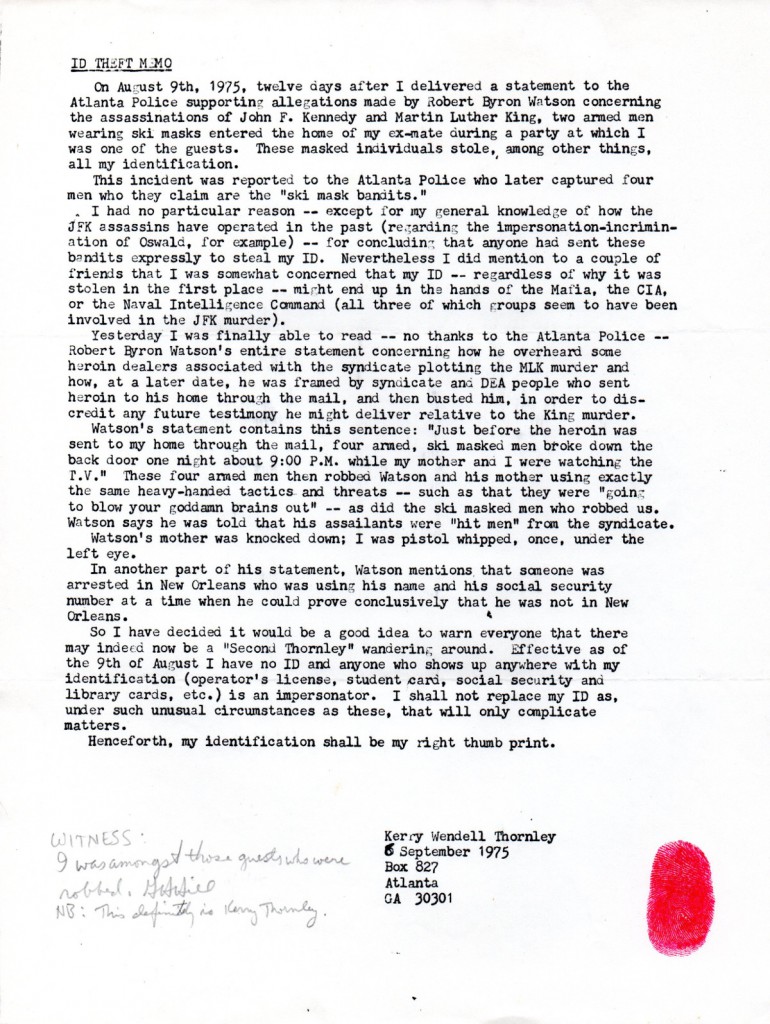
RAW attempted to bring some attention to Thornley’s plight by authoring an article called “Assassination Scene Heats Up,” which he sent to Kerry for comment. Download PDF here. Courtesy of The Discordian Archives.
As you can see, Thornley scrawled comments on each page, which became increasingly hostile as the pages turned, because he felt RAW was misinterpreting or not understanding him. However, the main reason RAW penned the piece in the first place was to help Kerry bring some attention to his claims. As far as I know, the article was never published.
Thornley began writing to me regularly about his solution to the assassinations, and insisted more and more often that his life was in danger. I tried to calm him down a bit by reminding him of the difference between theory and proof. It soon became evident, from his subsequent letters, that he was now half-convinced that I was part of the assassination conspiracy team. (p.156)
After sending out his JFK assassination related memos to Watson’s attorneys and other law enforcement officials, Kerry attended an Atlanta house party where he was given some “funny-tasting” marijuana. At this party he talked to a group of individuals about the JFK assassination, one of whom he suspected was RAW.
A few days later, Kerry met again with one of the party goers, who passed him a pipeload of weed that—after puffed upon—blistered the inside of his mouth, making him suspect someone was attempting to poison him. Kerry delivered an affidavit to the Atlanta police describing this incident, dated July 25th, 1975, along with the pot pipe and its contents:
“I have spoken to several people about the group of very nice people I met at a party at the Celestial Mansion on Flat Shoals Road last Saturday night.
“One person I met there who may or may not have been part of this group (which knew more about the JFK assassination re Gary Kirstein, it seemed, by what they said and the questions they asked me, than I do) was a guy who said his name was Jack Wolverton…“While we sat in the kitchen rapping, I filled up the enclosed pipe with a few leftover roaches and passed it to Jack. There was a long interval when my attention was directed elsewhere and Jack had the pipe.
“When he passed it back to me, I took a drag and IMMEDIATELY felt a large blister form inside my right check. Puzzled, I passed the pipe back to Jack, running my tongue over the blister. I did not observe carefully whether Jack actually smoked the pipe or merely made a pretense of doing so. When the pipe was returned to me, Eve, who had been out, came in the door. I took another puff only to have yet another blister, pop up right next to the other one at the exact time the smoke made contact with the membrane inside my cheek.
“Thinking it might be some sort of allergic reaction, I commented on it, and passed the pipe to Eve. She took a drag and experienced no unusual reactions.
“I then went into the bathroom and examined the blisters in the mirror. They were dark red blood blisters and each was about the size of a deformed collar button.
“I have had only one other experience with blisters forming instantly from any cause other than direct burns by fire, and that was in Atomic, Biological, and Chemical Warfare School (‘Defense’ I think they call it, not ‘Warfare’) in the Marines. That time our instructor demonstrated the effects of mustard gas to us by placing an infinitesimal amount on each of our fingertips—the result: instant blistering.
“I returned to the kitchen and commented that the blisters had formed when I had taken a drag on the pipe. Jack said: ‘Oh, I don’t think there is any relation.’ Something about the certainty of his unsolicited opinion, something about the tone of voice and timing—too hasty an interjection—has caused me to become very suspicious.
“Earlier I had asked Jack if he knew who those other people were at the Celestial Mansion or understood what we had been discussing. He said ‘no,’ that he had been playing music at the time on his guitar, which was true. He had been playing John Prine songs, which occupy a special place in my heart in relation to the Celestial Mansion because of a very high experience I had there in 1972 upon first discovering John Prine’s music. The whole incident at the Celestial Mansion had been carefully orchestrated by people who knew a great deal about me, people I correspond with, and the JFK assassination, particularly my involvement. I was made to feel as comfortable as possible, and then I was pumped just enough to see if it was Gary Kirstein that I was naming. (Does Kenner, Louisiana, mean anything to you was one of the questions I got asked.)
“On the way from The Plaza to the apartment was when I asked Jack if he knew those other people. He said he did not. I then explained to him what had happened and my suspicions concerning Gary Kirstein.
“Enclosed is the pipe and its contents, along with the plastic bottle the roaches were in before Jack got there, and to which he had no access. It seems to me this material should be analyzed. It was fished out of the trash by me a few days after the incident. Several important witnesses, including Ruby and Shaw died of cancer, for one thing, and some chemicals (nicotine for example) can stimulate cancer…”
In a follow-up memo dated July 27th, 1975, Kerry further addressed the pipe smoking incident:
“Occasionally in the past people have misinterpreted comments I have made which were only suggestive or indicative, taking them for firm opinions. I’m not at all sure whatever gave me those blisters was something intended to give me cancer, specifically. It could have been that stuff (Philip) Agee mentions in a recent PLAYBOY interview which causes a ‘nasty respiratory ailment.’ Since the smoke caused blisters in my mouth—which must have been sore in that spot—I didn’t inhale much of it. I do seem to have minor throat and lung irritation at this time. Just don’t want to seem like more of a crackpot paranoid than I really am after nearly twelve years of bizarre experience relating to JFK’s death.
“Also the ‘Celestial Mansion’ is the old name for a commune which was in the house I still call by that name. It is not the formal name of a business establishment.
“Upon checking, I have discovered that I have a sample of Jack Wolverton’s handwriting, for he wrote out his address for me in my notebook last week.
“Finally, concerning Wolverton, please give him the benefit of every doubt. I would hate to dump on him if his only mistake was that of befriending a person who happened to be feeling somewhat paranoid last week.
“I’m still very puzzled about the Celestial Mansion incident of last Saturday night. I continue to feel on a subjective level that the people who talked to me had my best interests at heart. It was as if they were checking me out to make sure I was not involved in the assassination. It was really stupid of me not to ask them how they came to know so much. One person who spoke to me, briefly, during the half-hour or so before the ‘team’ moved in, identified himself as Lew Deadmore. I find an architect by that name listed in the phone book. One of the members of the ‘team’—the one who spoke to me most—bore an uncanny intellectual and psychological resemblance to an anarchist writer friend of mine who lives-in California whom I have only met face-to-face once (in 1968), but with whom I’ve corresponded extensively. I have written him a letter about the incident, wondering if that was him. If it wasn’t he’ll probably think I’ve lost my mind.
“I doubt if I have been any too coherent about the Celestial Mansion incident. It requires more detail than I am inclined to deal with, considering the other writing I should be doing about Gary Kirstein. I’ll be glad to answer any questions about it, however. Meanwhile, let me summarize it by saying that I was questioned very informally but extremely skillfully by what seem to be a ‘team’ of five or six people who faded in and out of the crowd at a party. I’m quite sure this really happened and can give hard, objective reasons for so believing it was not just my imagination.”

In the above memo, SOME FURTHER COMMENTS ON THE PIPE SMOKING INCIDENT, Kerry notes that one member of the “team” at the Celestial Mansion, “…bore an uncanny intellectual and psychological resemblance to an anarchist writer friend of mine who lives in California whom I have only met face-to-face once (in 1968), but with whom I’ve corresponded excessively.” This “anarchist writer friend” was supposedly RAW.
In RAW’s intro to The Prankster and the Conspiracy, he wrote:
I remember my last phone conversation with Kerry, during which he announced that just a week earlier I had come to Atlanta, argued with him about my alleged CIA connections, spiked his drink with LSD, and brainwashed him again. I told him that I had not left San Francisco in months, and that if he had a bad acid trip the previous week then somebody else gave him the acid, not me. I insisted on this as persuasively as I could.
Finally, Kerry relented—a bit. “Well, maybe you believe that”, he said. “But that means your bosses have been fucking with your head and implanting false memories in you too!”
How do you argue that you haven’t had your head altered? “Look,” I said, I’ll put my wife Arlen on. She’ll tell you I haven’t left here in months.”
“That won’t prove anything,” he said with the calm certitude of a Grand Master announcing checkmate. “They probably fixed her head too.”
I don’t remember the rest of the conversation. I felt lost in an Escher painting…
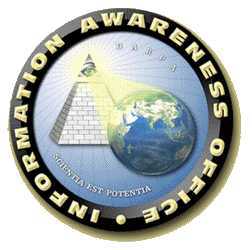 Established in January 2002 in the aftermath of 9/11, the Information Awareness Office (IAO) was a short-lived agency that oversaw the U.S. domestic surveillance program.
Established in January 2002 in the aftermath of 9/11, the Information Awareness Office (IAO) was a short-lived agency that oversaw the U.S. domestic surveillance program.
In 2003, IAO was axed by Congress following public criticism that the agency was overstepping its Constitutional authority. What with the in-your-face all-seeing eye in the triangle seemingly torn straight from the pages of Illuminatus!, the IAO seal possessed imagery suggesting an Orwellian nightmare come true, replete with an ominous death ray shooting a malevolent beam over the planet.

The Illuminatus! Trilogy.
In a May 2002 phone conversation, I asked Bob if “They” had intentionally lifted the IAO seal from the cover of The Illuminatus! Trilogy (Amazon). “I don’t know what the Hell’s going on,” Bob replied. “I think we’re being taken over by a bunch of surrealists.”
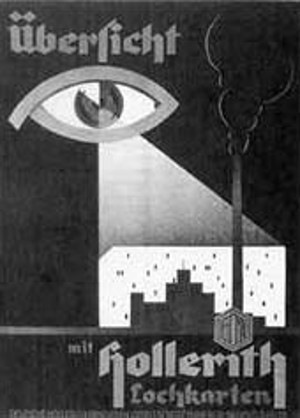
The more things change…

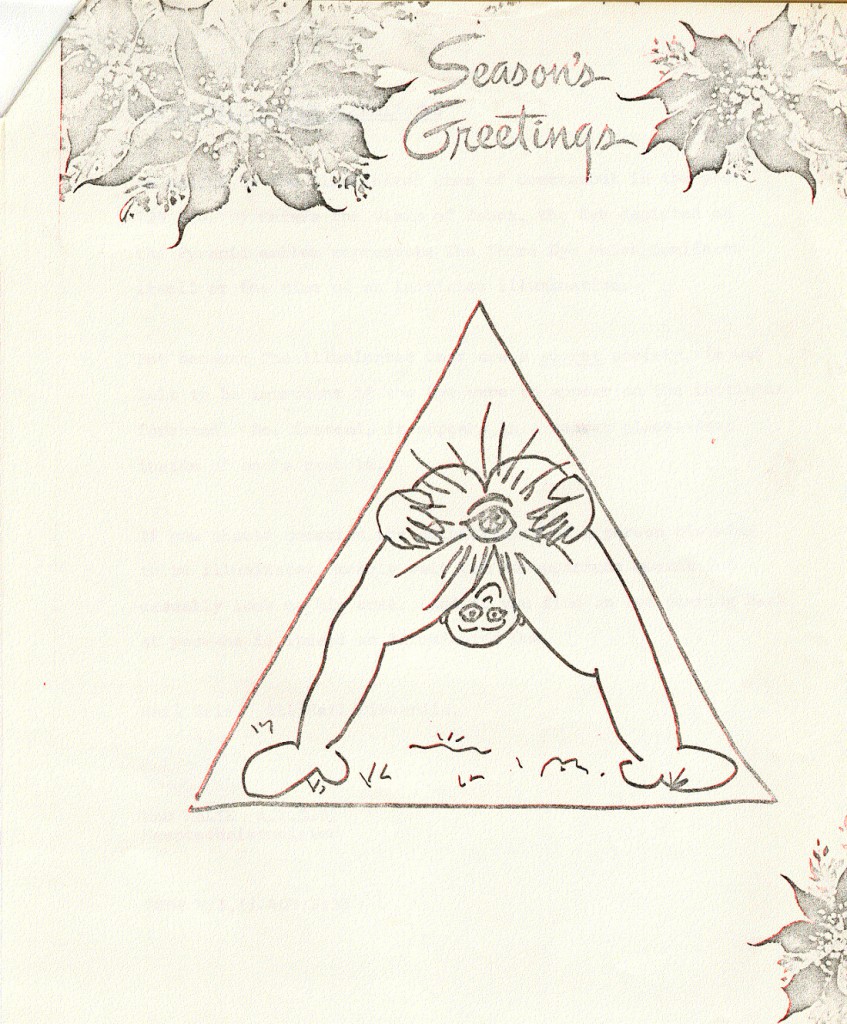
Grab the PDF here.
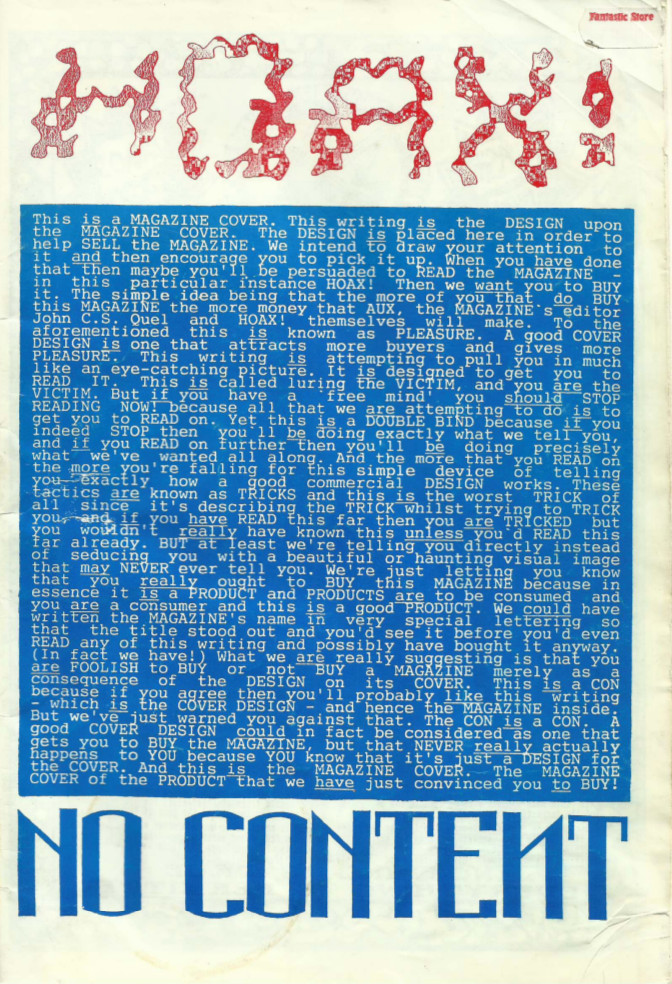
Gorightly interviewed by Jim Harold on Discordianism, Kerry Thornley, 23, The Church of the SubGenius, Robert Anton Wilson, and more!
http://jimharold.com
http://jimharold.net
Video by Floyd Anderson located here on The YouTube.
“Good news, folks, the ILLUMINATUS! comic I published back in 1987 is now in e-comic format, including text commentary. It’s a zip file available for download, and may end up at other sites in other formats. If you’re interested, download the comic and contact me about it. Some of the comments MAY be posted in further editions. There was one self-published issue, then 3 with Rip Off Press, and an unpublished 4th issue. Plans are for us to release one a month from now till we’re done.”
Mark was gracious enough to let us post the first installment (PDF) of the series here at Historia Discordia. —Adam Gorightly
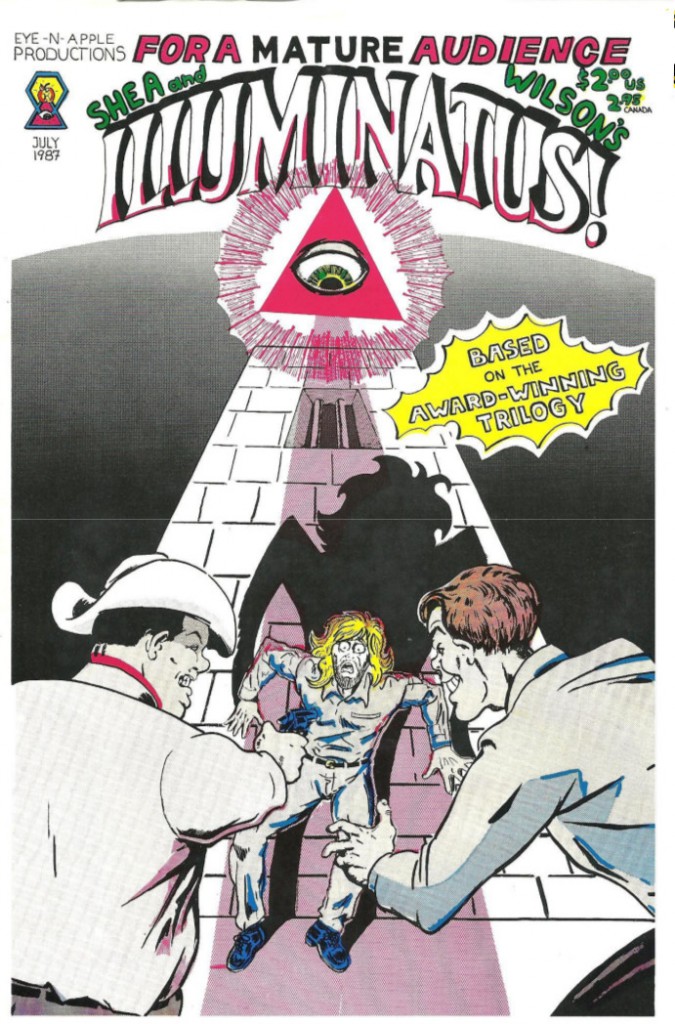
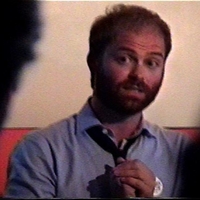
One of Discordianism’s two founders, Kerry Thornley, famously declared that if ‘religion is the opium of the masses, [then] Discordianism is the marijuana of the lunatic fringe,’ and this is made nowhere more clear than in its material culture over the last fifty-six years.2 The majority of Discordianism’s material culture has been comprised of self-published work in the form of religious certificates, ‘zines’, APAs (amateur press associations), live audio recordings of Robert Anton Wilson lectures, and, with the advent of the internet, BBSes (Bulletin Board System), PFDs, and blogs.3 The paper ephemera of Discordianism’s material history has not been catalogued by libraries, nor preserved by universities, but commonly remains in the possession of its initial recipients, or forgotten in the boxes that compose private zine archives. Lacking any familiarity with this ‘underground’ material, scholarly analysis of the mass-marketed Discordian texts, and Discordianism in toto, has been altogether superficial.
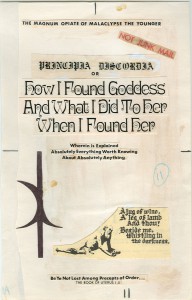
The second issue concerns the lack of scholarly convention concerning which version of the Principia is regarded as authoritative. As a result of the 4th edition Principia’s ‘copyleft,’ or anti-copyright status, there are no less than five different published versions of the 4th/5th edition, in addition to innumerable online versions. While there is not a great deal of difference between versions, scholarly neglect of this point, as well as the lack of convention concerning which version of the 4th/5th edition of the Principia should be treated as authoritative, has instilled an unnecessary amount of irregularity into the study of Discordianism.6
The third issue is partly based on the first, but regards a more general misinterpretation of the meaning of the Principia within the Discordian milieu. Scholars regard the 4th/5th edition of the text as the central Discordian holy work, and it is not hard to understand why; it seems to offer all of the requisite data for a normative appraisal of a religious movement. It contains an origin story for the religion, a list of commandments, a liturgical calendar, a list of saints, and an account of Discordianism’s principle deity, Eris. In sum, the 4th/5th edition of the Principia seems to be a perfect index of everything a ‘real’ religion needs. This, of course, is precisely the problem. Leaving aside the fact that many of the aforementioned ‘religious’ aspects of Discordianism were added in successive editions of the Principia, the primary issue here is that Discordianism is explicitly not based on liturgical observance or orthopraxis, but rather on the utilization of beliefs as heuristic tools. Scholarly preoccupation with the religious minutia contained in the Principia evidences that scholars have missed an essential aspect of the Discordian ludibrium.
Since the various publications of the 4th and 4th/5th editions of the Principia read like conventional holy texts, or at least as a parody of one, scholars have mistakenly taken it as the text that has governed Discordianism since its inception. While some contemporary Discordians may revere it as such, familiarity with previous editions of the text, let alone the history of Discordianism, make it clear that this was not always the case. Discordianism did not reach underground audiences until nearly two decades after it was founded, and even then it was not an edition of the Principia that publicized the religion, but a trilogy of novels. Despite having numerous quotes from the Principia, the fictitious nature of Robert Anton Wilson and Robert Shea’s Illuminatus! trilogy (1975) of novels led many to believe that the Principia did not actually exist á la Lovecraft’s Necronomicon. Needless to say, Discordianism’s underground popularization was not based on teachings outlined in the first, second, third, or fourth editions of the Principia, but Wilson and Shea’s interpretation of them in Illuminatus! The first widely popular edition of the Principia was published nearly five years after Illuminatus! as a result of Loompanics publisher Mike Hoy reading the trilogy, and querying Hill himself as to the existence of such a text.7 The shift to institutionalization in contemporary Discordianism has led to the formalization of Discordian beliefs, and, central to this has been the reframing of the Principia as foundational to the religion. The scholarly preoccupation with the contents of the Principia illustrates the way in which scholars’ research agendas owe more to the contemporary trend towards institutionalization within the religion than rigorous historical research on it.
Read in terms of its evolution and alongside other Discordian material, it is evident that the various editions of the Principia were never merely parodies of sacred texts, nor were they strictly genuine attempts to fashion one. Instead, they were iterations of an idiosyncratic form of genre appropriation based on the conviction that all beliefs are heuristic tools for creating models of reality. Said more precisely, the various editions of the Principia were not just satire, but prime examples of the assiduous playing with religious forms that epitomizes Discordian belief. Essentially, this type of humorous play functions as the liturgical language of Discordianism. Reflecting William Burroughs’s famous adage, ‘nothing is true and everything is permitted,’ Discordianism is a meta-belief system in which abstract concepts like ‘holy scripture’ are utilized as expedient means to destabilize fixed assumptions about reality. Though more salient in later editions, the Principia appropriated the genre of sacred scripture in the same way that Camden Benares’ Discordian treatise, Zen Without Zen Masters (1977), utilizes tropes associated with Zen koan books, and the same is true for the appropriation of conspiracy theory in Wilson and Shea’s Illuminatus! trilogy. Discordian texts have taken the form of science fiction epics, historical dramas, anarchist philosophy, psychologized-occult manuals, and Zen teachings, and regardless of their form, the dynamics of these genre appropriations are the same. Discordian authors appropriate genre conventions only to exploit their ability to communicate the central metaphysical truth of their religion, namely, that the experience of reality entirely depends on the belief system, or model through which it is comprehended.8
Christian Greer is a PhD researcher in the field of Western esotericism at the University of Amsterdam. His primary focus is the history and material culture of Discordianism, the Church of the SubGenius and the Moorish Orthodox Church, particularly in the 1980-1990s. His dissertation, Angelheaded Hipsters: From Beatnik Antinomianism to Psychedelic Millenarianism is an intellectual history of the “counterculture” beginning with the revolutionary movements of the 1960s and ending in the 1990s with cyberpunk and fin de siècle cyberculture.
https://uva.academia.edu/ChristianGreer
1 For a more detailed analysis of this problem in the work of one scholar, see Greer, Christian. ‘Review of Carole M. Cusack’s Invented Religions: Imagination, Fiction and Faith,’ Correspondences 2.1 (2014), pp. 109–114.
2 Thornley, Kerry. ‘Introduction’ in Principia Discordia 4th/5th edition, Lilburn, GA; Illuminet Press, 1991, p.i.
3 See Greer, ‘Occult Origins’, pp. 166-187.
4 The Loompanics edition (1979) is known as the ‘4th/5th edition’ because it reprinted the original 4th edition published by Rip Off Press in 1970, as well as the 5th edition, which was nothing more than a Western Union telegram filled with the letter ‘M’. The Loompanics version is most likely considered authoritative on account of it being the first to include the 5th edition telegram, as well as material that was not included in previous editions, e.g. ‘the Gypsie Skrypto interview,’ and an introduction by Robert Anton Wilson. For a more comprehensive overview of the publishing history of the Principia Discordia see Gorightly, Adam. ‘Adam Gorightly on the Publishing History of the Principia Discordia’ https://www.youtube.com/watch?v=bUqVrH4luXc accessed 04/05/13; see also f.8.
5 Cusack’s Invented Religion (2010) exemplifies this error insofar as her familiarity with the Principia Discordia is limited to two mass marketed 4th/5th editions of the text, which bear little resemblance to the first edition produced decades earlier. This is made obvious by the fact that she seems unaware that the first edition had a different title as well as entirely different contents. See Cusack, Carole. Invented Religions: Imagination, Fiction and Faith, Farnham: Ashgate, 2010, p.28-29 as compared to the first edition reproduced in Gorightly, Adam. Historia Discordia: The Origins of the Discordian Society. New York: RVP Press, 2014, pp.25-80. Cusack is by no means the only scholar to make this mistake, indeed, the difference between editions of the Principia has not been noticed within any notable study of Discordianism; see also Urban, Hugh. Magia Sexualis: Sex, Magic, Liberation in Modern Western Esotericism. Berkeley: University of California Press, 2006, p. 233-235; Versluis, Arthur. American Gurus: From Transcendentalism to New Age Religion. New York: Oxford University Press, 2014, p.123-138.
6 The three most important academic texts on Discordianism have all used different versions of the 4th/5th edition of the Principia: Cusack cites the Steve Jackson Games version in Invented Religion (2010), Urban references the Loompanics version in Magia Sexualis (2006), and Versluis based his work in American Gurus (2014) on the Illuminet edition.
7 The earliest version of the popular Loompanics edition of the Principia was published in 1979, and it featured an introduction by Hoy. This version was superseded by the popular 1980 edition, which contained Wilson’s introduction. See Gorightly, ‘Adam Gorightly on the Publishing History of the Principia Discordia’.
8 Wilson refers to the means by which an individual can ‘meta-program’ their own reality as the ‘final secret of the Illuminati’. See Wilson, Robert A. Cosmic Trigger: Final Secret of the Illuminati Vol.1, Tempe, AZ.: New Falcon Publications, 1997, pp.29, 68-71.
For those with the time (about 40 minutes)
and the interest, here’s the Full Interview entitled
“UFOs, Cults & Charles Manson Connections + Conspiracy with Adam Gorightly”:
Let us know what you think!